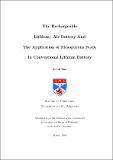Files in this item
The rechargeable lithium/air battery and the application of mesoporous Fe₂O₃ in conventional lithium battery
Item metadata
| dc.contributor.advisor | Bruce, Peter G. | |
| dc.contributor.author | Bao, Jianli | |
| dc.coverage.spatial | xvi, 151 | en_US |
| dc.date.accessioned | 2010-06-04T13:28:12Z | |
| dc.date.available | 2010-06-04T13:28:12Z | |
| dc.date.issued | 2009 | |
| dc.identifier | uk.bl.ethos.552336 | |
| dc.identifier.uri | https://hdl.handle.net/10023/897 | |
| dc.description.abstract | By replacing the intercalation electrode with a porous electrode and allowing lithium to react directly with O₂ from the air, the new rechargeable Li/O₂ battery system was studied. The porous cathode is comprised of carbon, catalyst and binder. The effect of every component was investigated. The catalyst was believed to play an important role in the performance of the electrode. A number of potential materials have been examined as the catalyst for the O₂ electrode. It suggests that the nature of the catalyst is a key factor controlling the performance of the O₂ electrode. Several catalysts based on first row transition metal oxides each with three different morphologies, bulk, nanoparticulate and mesoporous were studied. The influence of the morphology on the discharge and charge voltage, discharge capacity and cyclability were examined. Among all the catalysts studied, α-MnO₂ nanowires was found to be the best candidate. The reversible capacities of 3000 mAhg⁻¹(normalised by the mass of carbon) or 505 mAhg⁻¹ (based on the total mass of cathode + O₂ ) was obtained. Some of other factors, such as type of carbon, type of binder, type of electrolyte, the construction of cathode and the modification of the catalyst were also investigated, even just in the early stage. Capacity fading during cycling is the main problem in all the cases. A number of experiments were carried out to understand and attempt to avoid the fading problem. After successful synthesis of mesoporous α-Fe₂O₃ with unique properties (by Jiao et al.), the application of these materials in conventional Li battery was studied. Mesoporous α-Fe₂O₃ with ordered walls, mesoporous α-Fe₂O₃ with disordered walls and Fe₂O₃ nanoparticles were examined. It was also applied to examine the different factors that influence the rate of conversion electrodes, i.e., Li⁺ and e⁻ transport to and within the particles, as well as the rate of the two-phase reaction, demonstrating that for this conversion reaction electron transport to and within the particles is paramount. | en_US |
| dc.language.iso | en | en_US |
| dc.publisher | University of St Andrews | |
| dc.subject.lcc | TK2941.B27 | |
| dc.subject.lcsh | Storage batteries | en |
| dc.subject.lcsh | Lithium cells | en |
| dc.subject.lcsh | Cathodes--Materials | en |
| dc.subject.lcsh | Mesoporous materials | en |
| dc.title | The rechargeable lithium/air battery and the application of mesoporous Fe₂O₃ in conventional lithium battery | en_US |
| dc.type | Thesis | en_US |
| dc.type.qualificationlevel | Doctoral | en_US |
| dc.type.qualificationname | PhD Doctor of Philosophy | en_US |
| dc.publisher.institution | The University of St Andrews | en_US |
This item appears in the following Collection(s)
Items in the St Andrews Research Repository are protected by copyright, with all rights reserved, unless otherwise indicated.

